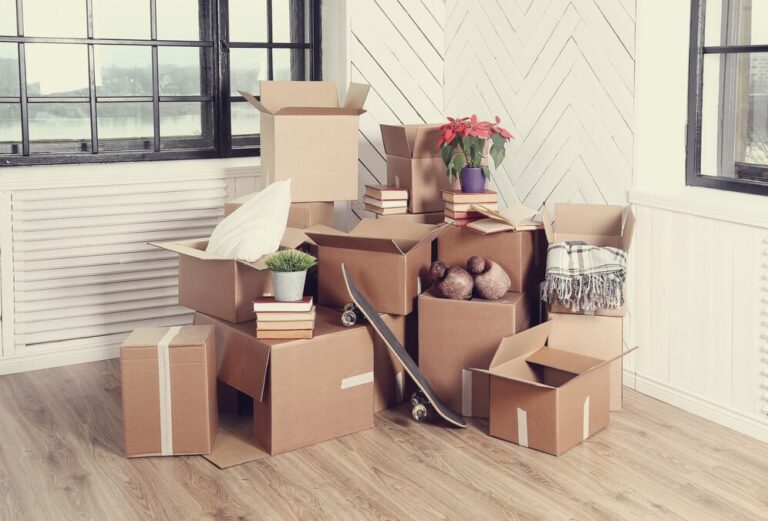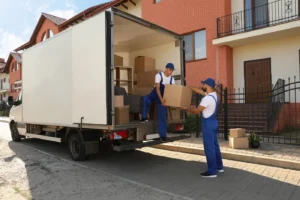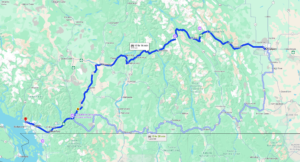Moving to Edmonton comes with its own set of challenges, especially when it comes to unpredictable weather. With freezing winters, rainy springs, and sudden temperature shifts, protecting your belongings during a move requires careful planning and the right packing techniques.
Whether moving in the middle of winter or during a rainy season, failing to prepare properly can lead to damaged furniture, breakage of fragile items, or moisture-ruining electronics.
In this guide, we’ll walk you through packing for Edmonton weather, ensuring your belongings remain safe, dry, and damage-free. From choosing the right packing materials to handling cold-sensitive items, these essential Edmonton moving tips will help make your relocation smooth and stress-free.
Understanding Edmonton’s Weather Challenges
Edmonton’s climate is known for its extremes, with long winters, fluctuating temperatures, and sudden weather changes that can impact your move. Winter months bring heavy snowfall and freezing temperatures, while spring and fall are characterized by rain and unpredictable shifts between warm and cold weather. Even summer can pose challenges, with occasional storms and high humidity affecting how you pack and transport your belongings.
Cold temperatures can make fragile items brittle, causing them to crack under pressure. Wooden furniture is particularly vulnerable, as dry air can lead to warping and splitting. Moisture from rain or snow can seep into boxes, damaging documents, fabrics, and electronics. Without proper weatherproof packing techniques, your valuable belongings may not survive the journey in the same condition.
Choosing the Right Packing Materials
Edmonton’s unpredictable weather—from snow and freezing temperatures to rain and humidity—can pose serious risks to your belongings during a move. Choosing high-quality packing materials is essential to keep your items safe from moisture, temperature fluctuations, and physical damage.
1. Use Weather-Resistant Packing Containers
Edmonton’s climate can be unpredictable, with snow, rain, and freezing temperatures posing risks to your belongings. The best packing service in Edmonton recommends using plastic bins for waterproof protection and double-walled cardboard boxes reinforced with heavy-duty tape to prevent moisture damage.
- Plastic bins: Ideal for clothes, books, and electronics, as they provide a waterproof barrier against snow and rain.
- Double-walled cardboard boxes: If you use cardboard, ensure it is reinforced and sealed with heavy-duty packing tape to prevent moisture absorption.
2. Wrap Fragile Items with Protective Layers
Fragile items are especially vulnerable during moves, as sudden temperature changes and moisture buildup can cause breakage or damage. Use layering packing materials to shield against condensation, shocks, and environmental exposure to ensure maximum protection.
- Packing paper: Acts as a moisture-absorbing barrier for delicate items like glassware, ceramics, and electronics. Wrap items in packing paper before using bubble wrap to prevent condensation buildup.
- Bubble wrap: Provides essential cushioning against impact but should always be applied over packing paper to prevent trapped moisture from damaging sensitive materials.
- Shrink wrap and plastic covers: They are crucial layers of defense for upholstered furniture, mattresses, and wooden surfaces, keeping them dry and safe from snow, rain, and humidity.
- Moving blankets: Protects large furniture like sofas and tables, providing insulation against temperature fluctuations while minimizing the risk of scratches, dents, and other physical damage during transit.
Combining these protective layers can prevent breakage, moisture damage, and temperature-related issues, ensuring your fragile belongings remain safe throughout your move to Edmonton.
Seal Boxes Properly to Prevent Moisture Damage
Even with the right packing materials, improper sealing can leave your belongings vulnerable to moisture damage from Edmonton’s unpredictable weather. Snow, rain, and condensation can easily seep into boxes if improperly secured.
- Heavy-duty packing tape: This strong, weather-resistant tape reinforces all box seams and edges to create a tight seal that blocks out moisture. Applying multiple layers along the bottom and top flaps adds extra durability.
- Plastic sheeting: Before packing items, line the bottoms of cardboard boxes with plastic. This prevents water absorption if boxes are placed on wet surfaces, such as snowy sidewalks or damp moving truck floors.
By using weatherproof packing for moving, you can effectively safeguard your belongings against Edmonton’s harsh climate, ensuring everything arrives at your new home in perfect condition.
Packing Strategies for Specific Items
Each type of item in your home requires a different approach to ensure it stays safe during a move in Edmonton’s unpredictable weather.
Electronics and Appliances
Cold weather can cause condensation inside electronics when moving from a warm home to freezing temperatures. This can lead to internal damage, affecting computers, televisions, and kitchen appliances. To avoid this, wrap electronics in anti-static bubble wrap and place them inside sealed plastic bags before packing them into boxes. Using their original packaging, if available, is the best way to ensure a snug and secure fit.
Glassware, Dishes, and Fragile Items
Delicate items such as glassware, plates, and decorative pieces are highly susceptible to cracking in cold temperatures. The best way to protect them is by using a double-layer wrapping technique. First, wrap each item in packing paper, then add a layer of bubble wrap before placing them in boxes lined with soft padding. Ensure there is no space inside the box—any gaps should be filled with crumpled paper or foam inserts to prevent movement during transport.
Wooden and Upholstered Furniture
Wood furniture is susceptible to temperature changes, as cold, dry air can cause it to shrink and crack. Applying a protective layer of polish or wax before packing your furniture can help maintain moisture levels. For added protection, wrap wooden furniture in moving blankets and secure them with shrink wrap. Upholstered furniture, including sofas and mattresses, should be covered with waterproof plastic covers to prevent moisture absorption.
Clothing, Bedding, and Fabrics
Fabric items are prone to mold and mildew if exposed to damp conditions during a move. Consider vacuum-seal bags or plastic storage bins instead of packing clothes in cardboard boxes. These not only save space but also provide an airtight, moisture-resistant seal. Using traditional moving boxes, line the inside with plastic sheeting for extra protection.
Packing for Cold, Rainy, and Snowy Moving Days
Edmonton’s weather can be unpredictable, so preparing for extreme conditions on moving day is essential.
Best Practices for Winter Moves
Moving in winter presents unique challenges, including icy roads and extreme cold. Schedule your move during daylight hours when temperatures are slightly warmer. Keep essential items readily accessible, such as warm clothing, blankets, and hot beverages, to stay comfortable throughout the process. Clearing pathways of snow and ice before moving heavy items can help prevent accidents and damage to your belongings.
Keeping Items Dry on Rainy Moving Days
If your moving day falls on a rainy day, extra precautions are needed to keep moisture away from your belongings. Using plastic covers and tarps can protect furniture and boxes from getting wet. Additionally, when loading the moving truck, line the floor with waterproof tarps to prevent water seepage into boxes, especially if items are placed temporarily during loading and unloading.
Labeling for Quick Unpacking in Extreme Weather
When dealing with unpredictable weather, knowing where everything is packed is essential. Label boxes clearly, especially those containing fragile or temperature-sensitive items. Mark “open first” boxes so you can quickly access crucial belongings like winter gear, hot drinks, and toiletries upon arrival.
Moving Day Tips for Weather Protection
Protecting your home is as important as protecting your belongings during a move. Placing floor mats and runners near entrances can prevent mud, water, and snow from being tracked inside. Using cardboard sheets or plastic covers in high-traffic areas can minimize mess and potential damage.
An emergency winter moving kit can be a lifesaver. Pack gloves, hand warmers, extra socks, a flashlight, and a portable phone charger in an easily accessible bag. Additionally, always check the weather forecast before moving day and have a backup plan in case of severe conditions.
Move with Confidence – Let Asr Moving Handle the Weather for You
Packing for Edmonton’s unpredictable weather can be stressful, but Asr Moving is here to help. Our packing service in Edmonton ensures your belongings are securely packed and transported safely, whether you’re facing snow, rain, or extreme cold.
With over 15 years of experience and 10,000+ happy customers, we specialize in weatherproof moving solutions, including secure storage, expert packing, and reliable transportation. Trust our Edmonton movers to handle every detail so you can focus on settling in.
Call us for your free quote, or visit our website to book your move!
FAQ
How can I prevent my moving truck from getting stuck in the snow?
To prevent your moving truck from getting stuck, ensure the driveway and surrounding areas are cleared of snow and ice before moving day. Use salt or sand to improve traction, and if possible, park the truck on a plowed road rather than a snow-covered driveway. Keeping a shovel and traction mats handy can also help in case the truck gets stuck.
Should I let my electronics acclimate before plugging them in after a winter move?
Yes, after moving electronics in cold weather, allow them to reach room temperature before turning them on. Rapid temperature changes can cause internal condensation, potentially leading to malfunctions. Let them sit for at least 24 hours before use.
What should I do if my packed boxes get damp from snow or slush?
If your boxes get damp, unpack them as soon as possible to prevent moisture damage. For slightly wet boxes, let them dry in a warm, ventilated area. If contents are affected, wipe down items and use a fan or dehumidifier to speed up drying. Consider using plastic bins for extra protection in future winter moves.
What’s the best way to protect plants during a winter move?
Cold temperatures can shock or kill plants, so wrap pots with blankets or bubble wrap to insulate them. Transport plants in your heated vehicle rather than the moving truck, and avoid leaving them in the cold for extended periods.
How can I keep my pets comfortable during a move in extreme weather?
To keep pets safe during a winter move, designate a warm, quiet space away from the moving chaos. If moving long-distance, keep them in a temperature-controlled vehicle with food, water, and blankets. Consider boarding them for the day to minimize stress.




